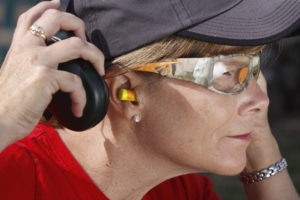Safety first! That warning particularly applies to any sport where firearms have a prominent position, but are thinking beyond the muzzle? In addition to firearm safety you should also consider safety to your body with hearing being front and center.
Hearing aids you throughout life, but particularly while hunting. Hearing the return howl of a nearby coyote or the snapping of a branch as a bobcat slips up to your hide could go unnoticed if you develop a hearing impairment. That’s why it’s important to protect your hearing at the range and in the field.
You likely wear protection at the range during a zeroing session,testing new ammunition or simply sending projectiles downrange for a weekend break. Are you doing the same in the field? That small detail is oftentimes overlooked since you’ll likely only be sending one or two bullets toward a predator on most outings. Nevertheless, those small bursts add up quickly and here are some facts to file away.
Sound is measured in decibels (dB) and according to the Occupational Safety and Health Administration hearing damage and loss can occur when exposed to sounds at 85 dB, or louder, for an 8 hour or greater period of time. Most modern firearms create 110 to 185 dB of sound. For sounds that are sudden, like a firearm blast, OSHA requires hearing protection when it exceeds 140 dB. Pain from loud noises may start at 125 dB, easily within reach of most firearms and particularly true if you have a muzzle brake attached.
A brake actually increases the noise of a firearm exponentially. Some of the data out there suggests the sound may actually be twice as loud as a typical the typical sound from a standard muzzle. Take note of that if you hunt with a brake on your firearm and neglect hearing protection. Moderate any loud noises with hearing protection and especially protect your ears if you utilize a muzzle brake to reduce the chances for hearing damage.
Ear muffs are a top choice for ease and reliability. Battery models, such as the Caldwell E-Max electronic hearing protection, allow you to hear normal conversations, yet automatically shut off with sounds at 85 dB or above. Companies like Cabela’s offer this model along with dozens of others that perform similarly like those from Walker.
For a less intrusive option consider protectors that insert into the ear canal such as the GhostStryke series by SportEar. They also shut down automatically with loud noises, but can increase normal hearing by six times so you don’t miss important range commands or a sneaky coyote behind your stand. Their tiny design and invisible signature make them a bit more expensive, but with care they can last for years. For a similar product without the hassle of batteries or the high price consider SureFire’s EarPro series of hearing protection. And yes, those foam plugs do work, especially if you use them correctly to block the entire ear canal. They also can help perform double duty when firing a REALLY noisy firearm, like the aforementioned types equipped with a muzzle brake. Unfortunately, they are not the best option as they can slip out and oftentimes are only good for loud noises that occur with long intervals in between.
Finally, suppressors can reduce the noise level of a firearm by 20 to 30 dB depending on the model and the firearm it is attached to. I recently applied to the Bureau of Alcohol, Tobacco, Firearms and Explosives for a suppressor produced by Dead Air Armament. And yes, I know the joke about those being the basis for any good party! Why go the suppressor route? Not only does a suppressor reduce noise, it reduces it enough where for one or two shots you don’t need to wear additional hearing protection.
That means I can howl to coyotes and listen for a response throughout the entire sit without putting hearing protection back on after the initial conversation. I can’t count the number of times I’ve had coyotes talk back to me later where I missed the conversation due to wearing hearing protection. Suppressors also aid in reducing recoil and give you the opportunity for a follow-up shot with predators oftentimes being confused due to the minimized sound signature from the firearm.
Regardless of the option you choose, use your hearing protection. Not only do you want to hear coyotes howling back in your future, you don’t want to be that guy or gal that continually shouts “what did you just say?”
Featured image: Mark Kayser







